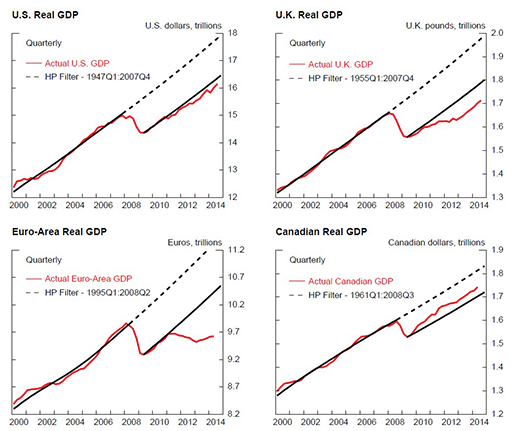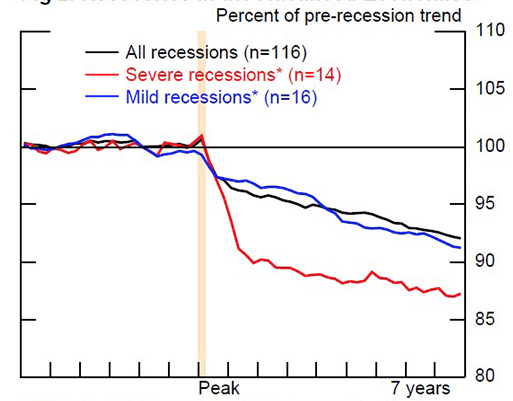A recent paper by the Federal Reserve looks at the impact of the global financial crisis on the economic recovery in many of the key economies of the world and whether the impact of major crises on economic output is temporary or permanent. This issue is particularly pertinent, given that the recovery since the Great Recession has been far weaker than what would normally be expected, particularly given the massive doses of monetary policy that the world's key central bankers have injected into their respective economies.
Here is a graphic showing the projected GDP trend (in dashed black) using the growth rate from the fourth quarter of 2007 and the actual GDP in red since the Great Recession for the United States, United Kingdom, Euro-area and Canada:
You'll notice that in each case, post-Great Recession GDP has fallen well short of where it would have been had the economy continued to grow at pre-Great Recession rates (the gap between the dashed black line and the red line). This could be termed an "output gap".
Here are the actual GDP/output gaps for the early months of 2014:
Note that the largest gap is in the Eurozone where 15.9 percent of potential GDP has been shaved off, followed by the United Kingdom at 14.07 percent, the United States at 9.93 percent and Canada at a rather measly 4.92 percent.
The study goes on to look at all 149 recessions since 1970 for 23 advanced economies to see how growth rates compare after recessions. Since the authors wish to measure the impact of both modest and severe recessions on economic growth, they exclude the Great Recession which leaves 117 recessions The authors calculate pre-recession trend growth as the four-year average growth rate for each country, two years prior to each peak and examine GDP as a percentage of this trend for each recession prior to the Great Recession. By excluding the two years prior to a cyclic peak, the authors are able to exclude periods of potential "bubble-like" growth that may boost trend growth rates.
Here are their results:
The black line shows the level of real GDP as a percentage of its pre-recession trend around all 117 recessions, the blue line shows the level of real GDP as a percentage of its pre-recession trend for severe recessions and the blue line shows the level of real GDP as a percentage of its pre-recession trend for mild recessions. On average, GDP remains well below the previous trend for both mild and severe recessions although the loss of output is greater for severe recessions. You'll notice that the negative impact of even mild recessions on economic growth rates for even mild recessions appears to persist.
Widely followed economic models have generally assumed that recession-induced output gaps will close over time because post-recession economies experience a period of above trend growth (i.e. there is a surge in economic activity, both output and demand for that output, that makes up for the lost activity during the recession that pushes the economy back to its long-term trend growth rates). This suggests that recessions of all types, including those that are relatively mild, may have a permanent dampening effect on demand. The research also shows us that the severity of the Great Recession on the global economy has resulted in a strong and permanently negative impact on demand that has depressed economic growth rates. It would appear that, despite the unprecedented intercession of central banks and their monetary experiments, the global economy is highly unlikely to return to its pre-Great Recession growth rates anytime soon. This is particularly concerning for Europe where economic growth rates look extremely anemic nearly six years after the end of the latest recession.
So much for trillions of dollars worth of quantitative easing and twisting!
Click HERE to read more of Glen Asher's columns
You can publish this article on your website as long as you provide a link back to this page.




Be the first to comment